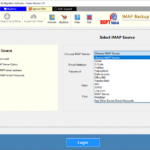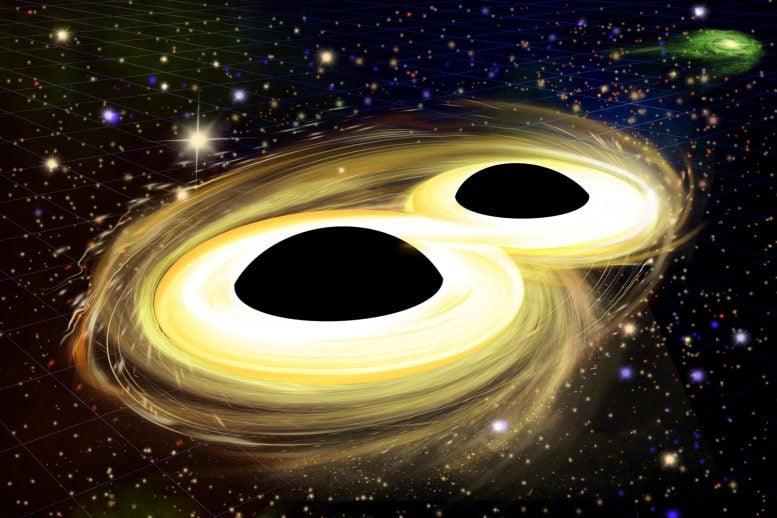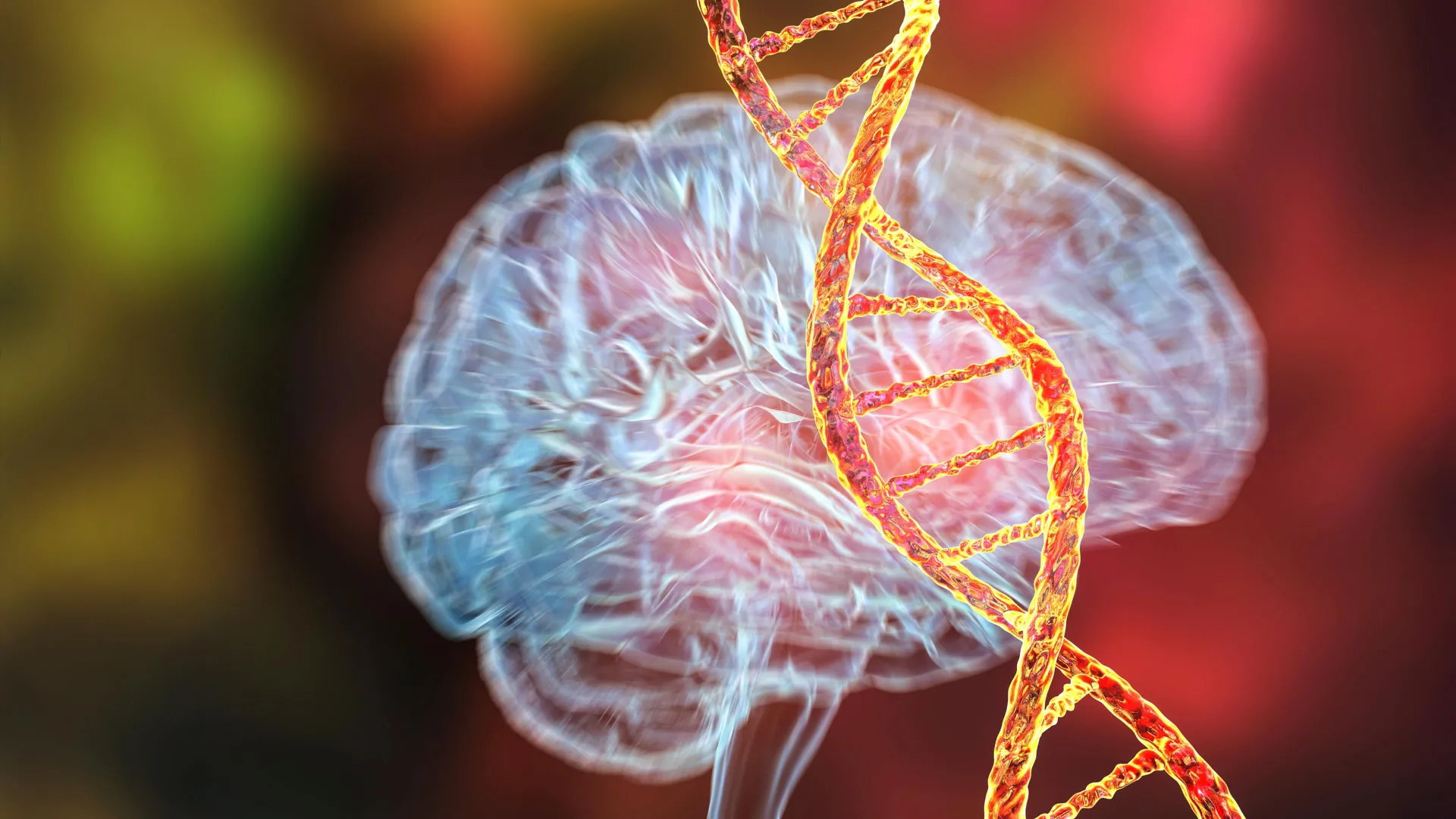The phenomenon of differential rotation in the Sun, described by equation 1 where A is the equatorial rotation speed, A and C are latitudinal gradients, and \theta$ is the latitude, is a cornerstone of solar dynamo theory. While helioseismology and feature tracking at optical and EUV wavelengths have helped map this profile at the surface and deep interior, ambiguity persists in the upper layers of the solar atmosphere, largely due to uncertainties in the emission height of temperature-sensitive EUV tracers.
\[\Omega= A + B\sin^2{\theta} + C \sin^4{\theta}\] (Equation 1)
The recent study Routh et al. (2025) take advantage of a tracer-independent image correlation approach using 17 GHz radio imaging from the Nobeyama Radioheliograph (NoRH)that sample from a relatively well-defined height in the upper chromosphere (~3000 ± 500 km), to analyze the differential rotation of the solar atmosphere at the same height and compare it with EUV and white light-based observations. Radio diagnostics on this frequency mainly arise from thermal bremsstrahlung, which makes them much less sensitive to temperature variations compared to EUV channels (Zirin 1988).
Data and analysis
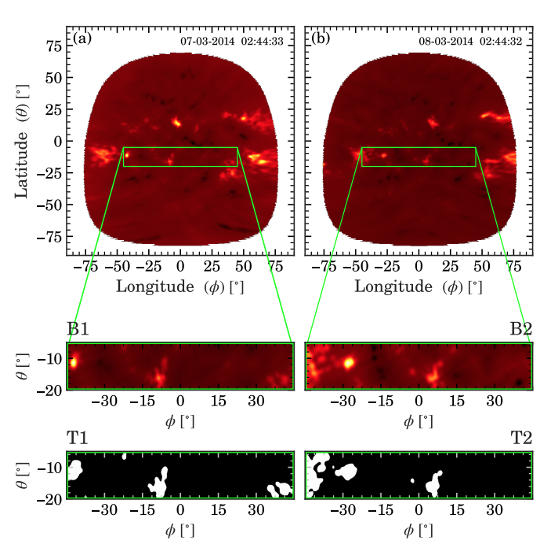
Figure 1: A set of images in (a) 7th March, 2014 and (b) 8th March 2014 Nobeyama data set after conversion to Stonyhurst heliographic coordinates. B1 and B2 represent the bins where image correlation is applied. Bins T1 and T2 represent the dominant bright features in the same bins that largely contribute to the correlation, as demonstrated by the adaptive intensity threshold.
We use 28 years of daily 17 GHz full-disk radio images (1992-2020) and apply an automated, tracer-independent image correlation technique. By dividing each solar image into overlapping latitudinal bins (15$^{\circ}$ wide) and maximizing the 2D cross-correlation of temporally separated segments (B1 and B2 in Fig. 1), the method determines sidereal rotation rates without relying on visible features such as sunspots or blights. Importantly, the method works well even during solar minimum, when features are scarce. This makes it a powerful tool for robust, long-term monitoring of large-scale flow patterns in the chromosphere.
Comparing the rotation profile of the solar chromosphere with that obtained for sunspots and photospheric plasma, we find much faster rotation rates at all latitudes and a comparatively less differential nature of its rotation is also evident (Fig. 2; Left panel). Previously, an increasing trend in equatorial rotation rates had been studied by Routh et al. (2024) and the current results fit this trend (Fig. 2; Right panel).
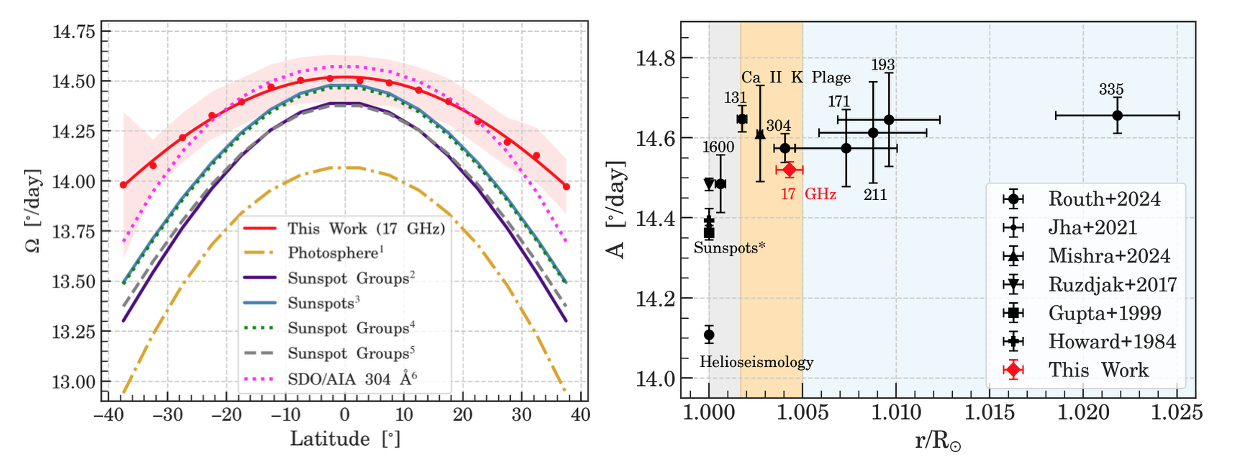
Figure 2 : The rotation profile for 17 GHz compared to the values of compared to the rotation profiles of 1Snodgrass (1983), 1984), 2Howard et al. (1984), 3Poljanˇci´c Beljan et al. (2017), 4Ruždjak et al. (2017), 5Jha et al. (2021) and 6 Routh et al. (2024).
A weak negative correlation of the equatorial rotation rate (A) with solar activity is also found (Fig. 3), which also coincides with the fact that differential rotation could suffer a phenomenon known as magnetic braking when solar activity increases.
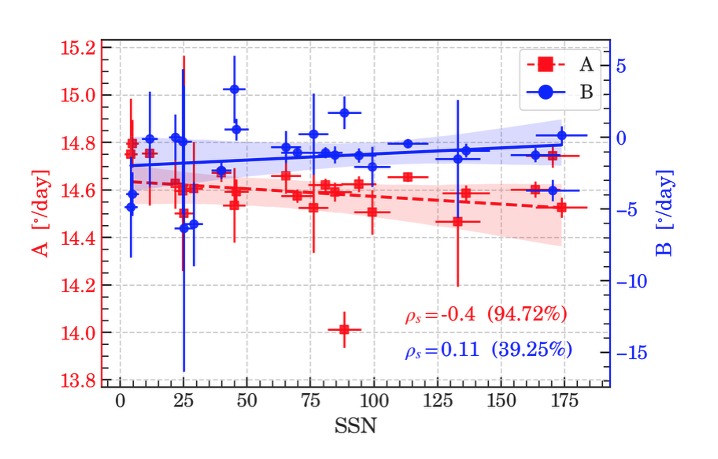
Figure 4: Correlation plot of the equatorial rotation rate (A; in red) and the latitudinal gradient (B; in blue) with the annual number of sunspots and their error estimate in the y and x directions, respectively.
Conclusions
Our findings reaffirm the potential of radio observations to investigate the dynamics of the solar chromosphere with reduced height ambiguity. The superposition of the equatorial rotation rate (A) found in this study with that of 304 \AA in the EUV regime provides additional support for the view that equatorial rotation rates increase with height above the photosphere. Future coordinated studies at wavelengths with better constrained height formation will be crucial to better understand the complex dynamics of the solar atmosphere.
Additional information
Based on the recent study by Routh, S., “Insights into chromospheric large-scale flows using Nobeyama 17 GHz radio observations: I. The differential rotation profile”, Astronomy and Astrophysics Lettersvol. 700, art. No. L3, 2025. doi:10.1051/0004-6361/202555364
Codes for bright region extraction and image correlation can be found here:
https://github.com/srinjana-routh/Bright-Regions-Nobeyama, https://github.com/srinjana-routh/Image-Correlation
References
Poljanˇci´c Beljan, I., Jurdana-Šepi´c, R., Brajša, R., et al. 2017, Astronomy and Astrophysics, 606, A72
Routh, S., et. al, “Exploring the dynamic rotational profile of the hottest solar atmosphere: a multi-wavelength approach using SDO/AIA data,” The Astrophysical Journal, vol. 975, 158, PIO, 2024
#differential #rotation #profile #Routh #Community #European #Solar #Radio #Astronomers
